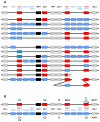Review: Immunogenetics of human placentation
- PMID: 22177321
- PMCID: PMC3677947
- DOI: 10.1016/j.placenta.2011.11.020
Review: Immunogenetics of human placentation
Abstract
Natural killer (NK) cells are a population of lymphocytes that function in both immune defense and reproduction. Diversifying NK cell phenotype and function are interactions between NK cell receptors and major histocompatibility complex (MHC) class I ligands. As a consequence of strong and variable selection these ligand-receptor systems are polymorphic, rapidly evolving, and considerably species-specific. Counterparts to the human system of HLA class I ligands and killer cell immunoglobulin-like receptors (KIR) are present only in apes and Old World monkeys. HLA-C, the dominant ligand for human KIR and the only polymorphic HLA class I expressed by trophoblast, is further restricted to humans and great apes. Even then, the human system appears qualitatively different from that of chimpanzees, in that it has evolved a genetic balance between particular groups of receptors and ligands that favor reproductive success and other groups of receptors and ligands that have been correlated with disordered placentation. Human populations that have survived successive episodes of epidemic disease and population bottlenecks maintain a breadth of diversity for KIR and HLA class I, implying that loss of such diversity disfavors long-term survival of a human population.
Copyright © 2012 Elsevier Ltd. All rights reserved.
Conflict of interest statement
The authors have no conflict of interest to declare.
Figures
Similar articles
-
Maternal KIR and fetal HLA-C: a fine balance.J Leukoc Biol. 2011 Oct;90(4):703-16. doi: 10.1189/jlb.0511227. Epub 2011 Aug 26. J Leukoc Biol. 2011. PMID: 21873457 Review.
-
Uterine natural killer cells: from foe to friend in reproduction.Hum Reprod Update. 2021 Jun 22;27(4):720-746. doi: 10.1093/humupd/dmaa062. Hum Reprod Update. 2021. PMID: 33528013 Review.
-
Natural killer-cell immunoglobulin-like receptors trigger differences in immune response to SARS-CoV-2 infection.PLoS One. 2021 Aug 5;16(8):e0255608. doi: 10.1371/journal.pone.0255608. eCollection 2021. PLoS One. 2021. PMID: 34352002 Free PMC article.
-
Variation of maternal KIR and fetal HLA-C genes in reproductive failure: too early for clinical intervention.Reprod Biomed Online. 2016 Dec;33(6):763-769. doi: 10.1016/j.rbmo.2016.08.019. Epub 2016 Sep 5. Reprod Biomed Online. 2016. PMID: 27751789
-
Human-specific evolution and adaptation led to major qualitative differences in the variable receptors of human and chimpanzee natural killer cells.PLoS Genet. 2010 Nov 4;6(11):e1001192. doi: 10.1371/journal.pgen.1001192. PLoS Genet. 2010. PMID: 21079681 Free PMC article.
Cited by
-
Maternal uterine NK cell-activating receptor KIR2DS1 enhances placentation.J Clin Invest. 2013 Oct;123(10):4264-72. doi: 10.1172/JCI68991. Epub 2013 Sep 16. J Clin Invest. 2013. PMID: 24091323 Free PMC article.
-
Identification of trophoblast-specific elements in the HLA-C core promoter.HLA. 2018 Nov;92(5):288-297. doi: 10.1111/tan.13404. Epub 2018 Oct 30. HLA. 2018. PMID: 30270560 Free PMC article.
-
Characterisation of major histocompatibility complex class I genes at the fetal-maternal interface of marsupials.Immunogenetics. 2015 Jul;67(7):385-93. doi: 10.1007/s00251-015-0842-5. Epub 2015 May 9. Immunogenetics. 2015. PMID: 25957041
-
Uncovering the peptide-binding specificities of HLA-C: a general strategy to determine the specificity of any MHC class I molecule.J Immunol. 2014 Nov 15;193(10):4790-802. doi: 10.4049/jimmunol.1401689. Epub 2014 Oct 13. J Immunol. 2014. PMID: 25311805 Free PMC article.
-
Large-Scale Imputation of KIR Copy Number and HLA Alleles in North American and European Psoriasis Case-Control Cohorts Reveals Association of Inhibitory KIR2DL2 With Psoriasis.Front Immunol. 2021 Jun 11;12:684326. doi: 10.3389/fimmu.2021.684326. eCollection 2021. Front Immunol. 2021. PMID: 34177931 Free PMC article.
References
-
- Snell GD. Immunogenetics: Retrospect and prospect. Immunogenetics. 1974;1(1):1–3.
-
- Medawar PB. Some immunological and endocrinological problems raised by the evolution of viviparity in vertebrates. Symp Soc Exp Biol. 1953;7:320–338.
-
- Thorsby E. A short history of HLA. Tissue Antigens. 2009;74(2):101–16. - PubMed
-
- Star B, Nederbragt AJ, Jentoft S, Grimholt U, Malmstrom M, Gregers TF, Rounge TB, Paulsen J, Solbakken MH, Sharma A, Wetten OF, Lanzen A, Winer R, Knight J, Vogel JH, Aken B, Andersen O, Lagesen K, Tooming-Klunderud A, Edvardsen RB, Tina KG, Espelund M, Nepal C, Previti C, Karlsen BO, Moum T, Skage M, Berg PR, Gjoen T, Kuhl H, Thorsen J, Malde K, Reinhardt R, Du L, Johansen SD, Searle S, Lien S, Nilsen F, Jonassen I, Omholt SW, Stenseth NC, Jakobsen KS. The genome sequence of Atlantic cod reveals a unique immune system. Nature. 2011;477(7363):207–10. - PMC - PubMed
-
- Apps R, Murphy SP, Fernando R, Gardner L, Ahad T, Moffett A. Human leucocyte antigen (HLA) expression of primary trophoblast cells and placental cell lines, determined using single antigen beads to characterize allotype specificities of anti-HLA antibodies. Immunology. 2009;127(1):26–39. - PMC - PubMed
Publication types
MeSH terms
Substances
Grants and funding
LinkOut - more resources
Full Text Sources
Medical
Research Materials








